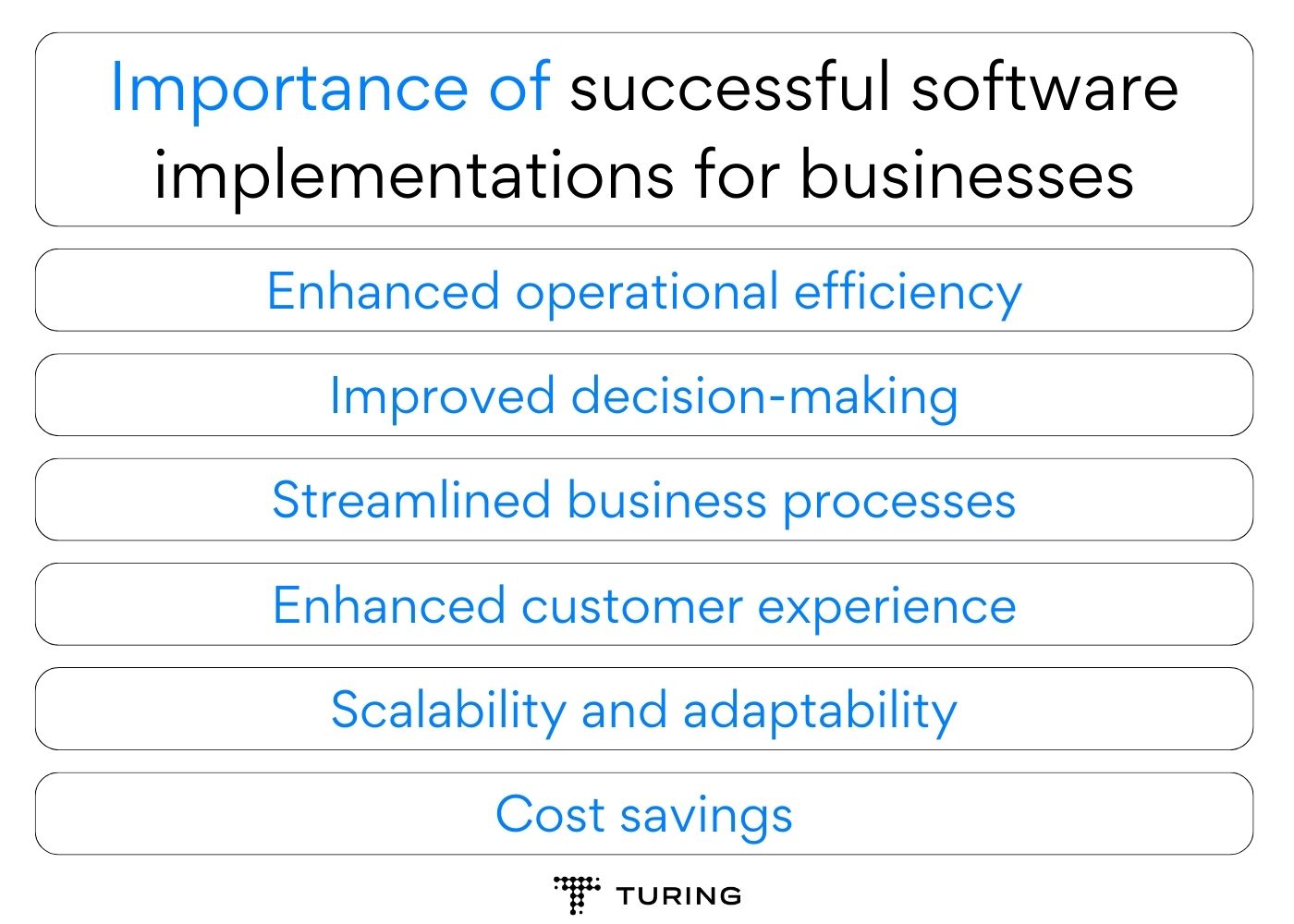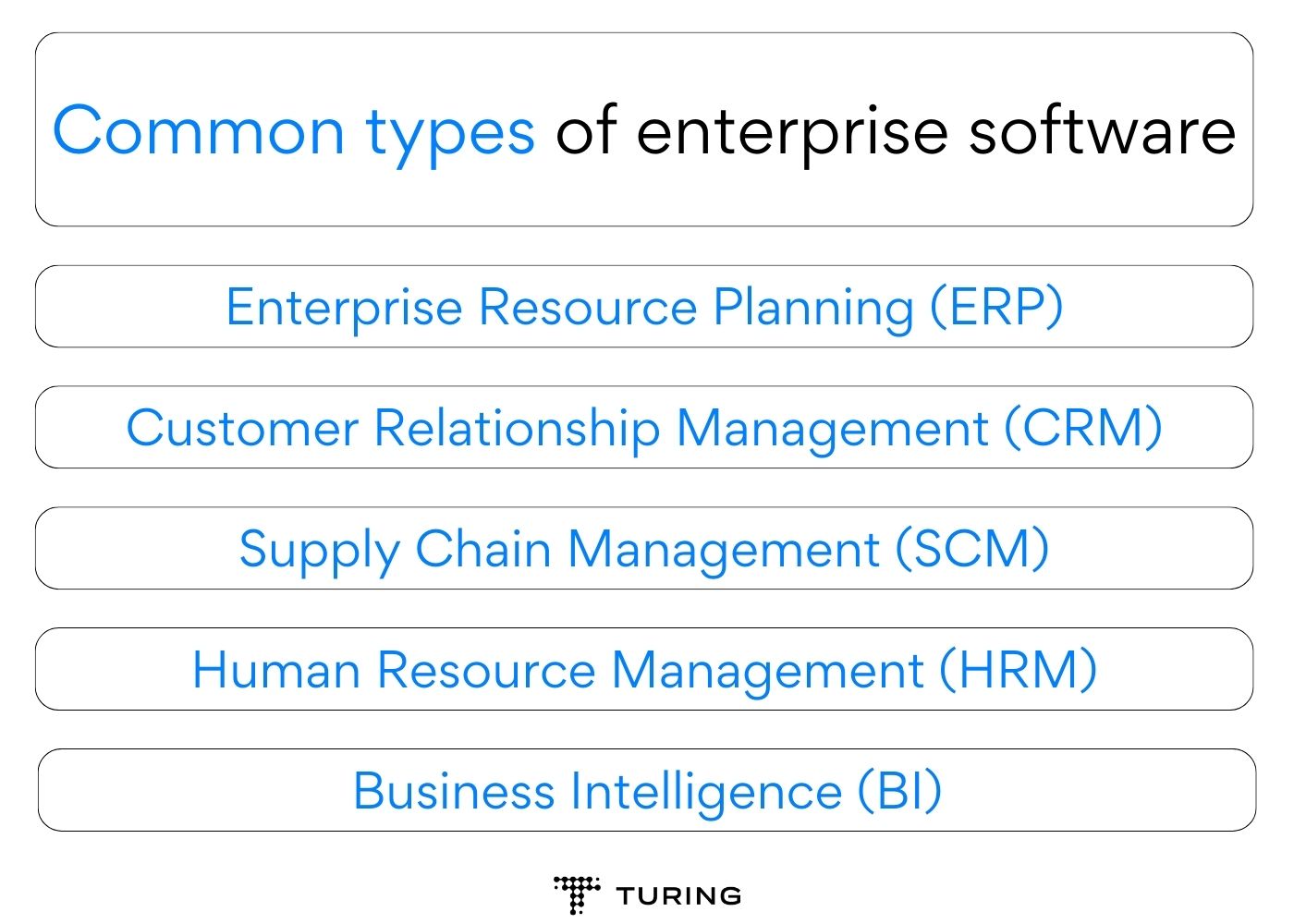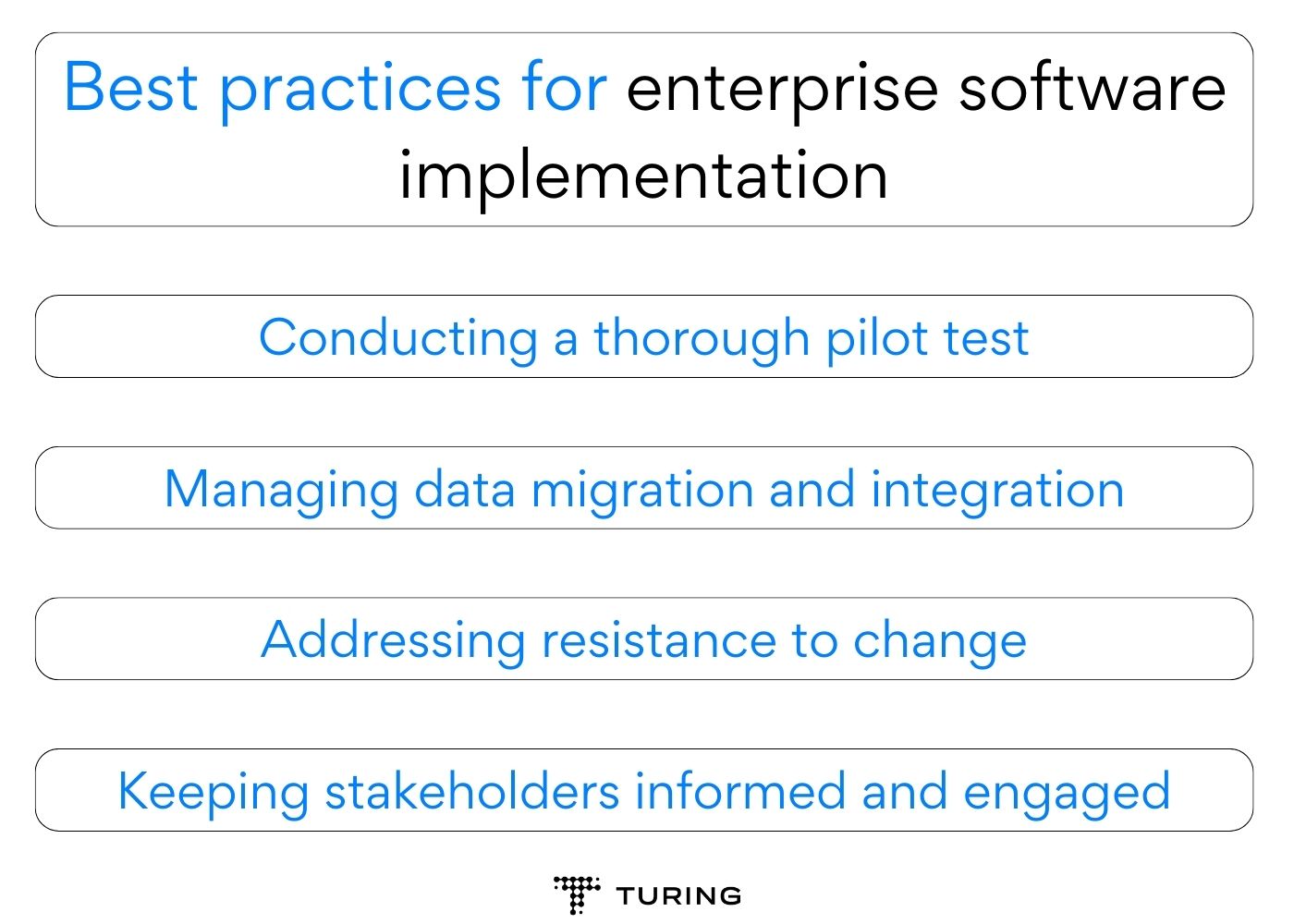Decoding Success in Enterprise Software Implementations: A Comprehensive Guide
Establishing an enterprise software implementation system is critical for any organization embarking on a journey to deploy a new enterprise system. Whether it involves replacing an existing on-premises solution, enhancing capabilities in a cloud environment, or initiating a greenfield deployment to replace outdated spreadsheets and homegrown software, the success of the chosen enterprise solution hinges on a well-executed implementation.
Achieving this success demands meticulous planning and execution, coupled with the expertise of experienced and knowledgeable resources. This includes user adoption, process alignment, data quality, and overall enterprise fit.
These implementations lead to enhanced operational efficiency, improved decision-making, and streamlined processes, contributing to sustainable growth and increased profitability.
In this blog, we’ll delve deeper into the various facets of enterprise software implementations, equipping enterprises and companies with the knowledge and insights they need to embark on this journey with confidence and set the stage for long-term success.
Let’s dig in!
Overview of enterprise software implementations
Enterprise software implementations refer to integrating and deploying complex software systems tailored to meet an organization’s unique needs. These implementations can encompass a wide array of business areas, such as Enterprise Resource Planning (ERP), Supply Chain Management (SCM), Customer Relationship Management (CRM), and Human Resource Management (HRM), among others.
The implementation process involves careful planning, configuration, testing, training, and deployment of the software across various departments and functions within the organization. As the scale of the enterprise grows, the complexity of the implementation increases, making it a challenging task that requires expertise, collaboration, and clear communication between all stakeholders involved.
Importance of successful software implementations for businesses

Importance of successful software implementations for businesses
- Enhanced operational efficiency: A well-executed enterprise software implementation can significantly enhance operational efficiency by automating processes, reducing manual errors, and optimizing resource allocation. This efficiency boost empowers employees to focus on strategic tasks, fostering a culture of productivity and innovation.
- Improved decision-making: Enterprise software solutions provide access to real-time data and analytical tools that enable data-driven decision-making. This ability to make informed choices based on accurate insights can lead to more effective strategies and higher chances of business success.
- Streamlined business processes: Successful software implementations align and integrate various business processes, breaking down silos and facilitating seamless information flow across departments. This integration streamlines workflows, reduces redundancies, and creates a cohesive organizational structure.
- Enhanced customer experience: An enterprise software implementation often includes CRM systems that help businesses better understand their customers, track interactions, and deliver personalized experiences. This, in turn, leads to improved customer satisfaction and loyalty.
- Scalability and adaptability: The right enterprise software can scale along with business growth and adapt to changing market demands, allowing organizations to remain agile and responsive in a dynamic environment.
- Cost savings: Although the initial investment in enterprise software may be substantial, the long-term cost savings from process efficiencies and reduced manual labor can be significant, ultimately resulting in a positive return on investment (ROI).
Understanding enterprise software implementations

Common types of enterprise software
Enterprise software refers to a category of business applications specifically designed to cater to the needs of large-scale organizations. These robust solutions are comprehensive and are intended to integrate and optimize a wide range of business processes and functions. Here are some common types of enterprise software:
- Enterprise Resource Planning (ERP): ERP systems unify and streamline various core business processes like finance, human resources, supply chain management, and inventory control into a centralized platform.
- Customer Relationship Management (CRM): CRM software focuses on managing and enhancing customer interactions, lead generation, sales, and marketing efforts.
- Supply Chain Management (SCM): SCM solutions facilitate efficient management of the entire supply chain, from procurement and logistics to inventory and distribution.
- Human Resource Management (HRM): HRM software aids in automating HR processes, including recruitment, employee onboarding, performance management, payroll, and benefits administration.
- Business Intelligence (BI): BI tools offer advanced data analytics and reporting capabilities, empowering enterprises to make data-driven decisions.
Key challenges faced during implementations
While the benefits of enterprise software implementations are immense, they come with their share of challenges. Here are some key obstacles that enterprises often encounter during the deployment process:
- Integration complexities: Integrating enterprise software with existing systems and applications can be complex, particularly when dealing with legacy systems that lack compatibility.
- Data migration issues: Transferring large volumes of data from legacy systems to the new enterprise software can lead to data integrity and accuracy concerns, often resulting in data migration issues.
- Resistance to change: Employees may resist adopting new systems due to fear of the unknown, lack of training, or a reluctance to move away from familiar processes.
- Project scope creep: Expanding the project scope beyond its initial boundaries can lead to resource overutilization, budget overruns, and delayed timelines.
- Common reasons for implementation failures: Implementation failures are often caused by inadequate planning, poor communication, lack of top management support, and insufficient training.
Preparing for a successful implementation
When it comes to adopting enterprise software solutions, a successful implementation can make all the difference in achieving organizational objectives. However, this process is not without its challenges, and careful preparation is crucial. Let’s explore the key steps enterprises must take to ensure a successful software implementation.
-
Assessing business needs and objectives
The first step in preparing for a successful implementation is a comprehensive assessment of the organization’s needs and objectives. This involves engaging with stakeholders, department heads, and end-users to understand their pain points, requirements, and long-term goals. Gaining a deep understanding of the current processes and workflows will help identify areas that can be optimized through the new software.
Additionally, setting clear and measurable objectives for the implementation project is vital. These objectives should be closely aligned with the broader business strategy and communicated effectively to all relevant stakeholders. Whether the goal is to improve efficiency, elevate customer experience, or streamline supply chain management, a well-defined set of objectives will guide the entire implementation process toward success. -
Identifying the right software solution
Selecting the most suitable software solution is a critical decision that requires careful evaluation. Enterprises have two primary options to consider: off-the-shelf and custom software.
-
-
Evaluating off-the-shelf vs. custom software:
Off-the-shelf software solutions are pre-packaged applications that cater to common business needs and are ready for deployment. They are typically more cost-effective and have shorter implementation timelines. However, they may not fully align with the organization’s unique requirements and may require some customization.
On the other hand, custom software solutions are tailor-made to precisely fit the organization’s needs and workflows. While they may require more significant upfront investment and a longer implementation timeline, they offer unparalleled alignment with the business processes, scalability, and flexibility.
To make an informed decision, organizations must carefully weigh the benefits and drawbacks of each option, considering factors such as budget, time constraints, and the complexity of business needs. -
Key features to look for in enterprise software
Irrespective of whether you opt for off-the-shelf or custom software, certain key features are crucial for enterprise-grade solutions:- Scalability: The software should grow and adapt with your business to accommodate future expansions and changing needs.
- Integration capabilities: Seamless integration with existing systems ensure smooth data flow and reduces disruptions during the implementation process.
- Security: Enterprise software must adhere to robust security standards to safeguard sensitive business data.
- User-friendly interface: An intuitive and user-friendly interface is essential to minimize training time and boost user adoption.
-
-
Assembling a competent implementation team
Behind every successful software implementation lies a competent and dedicated implementation team. Clearly defining the roles and responsibilities of each team member is essential to ensure seamless collaboration and efficient progress.- Roles and responsibilities of team members: The implementation team typically comprises representatives from various departments, including IT, operations, finance, and human resources. Key roles may include project managers, software developers, data analysts, and end-user representatives.
- Importance of executive sponsorship: Having executive sponsorship for the implementation project is critical for securing the necessary resources, support, and buy-in from top-level management. A senior executive sponsor can help remove obstacles, keep the team motivated, and ensure alignment with the organization’s strategic goals.
-
Creating a detailed implementation plan
A well-defined implementation plan is the backbone of a successful rollout. The plan should include:- Timeline: Set realistic and achievable milestones to track progress effectively.
- Resource allocation: Allocate the necessary budget, personnel, and technology resources to ensure a smooth implementation.
- Risk assessment: Identify potential risks and devise mitigation strategies to minimize disruptions.
- Training: Develop a comprehensive training program to equip employees with the necessary skills to use the new software effectively.
- Communication: Keep all stakeholders informed about the progress, changes, and expected benefits throughout the implementation journey.
Best practices for enterprise software implementation

Best practices for enterprise software implementation
Implementing new technology solutions within enterprises and companies can be a complex and challenging process. To achieve a successful transition and maximize the benefits of the new system, it is essential to follow best practices during implementation. These key practices can help enterprises navigate the implementation process smoothly and effectively.
-
Conducting a thorough pilot test
Before rolling out the new technology solution across the entire organization, conducting a thorough pilot test is a crucial step. The pilot test involves deploying the system on a smaller scale, typically in a specific department or business unit, to identify any potential issues or areas for improvement.
During the pilot test, gather feedback from end-users and key stakeholders to understand their experiences and assess the system’s performance in a real-world environment. This feedback will enable the implementation team to address any issues and make necessary adjustments before the full-scale deployment.
Moreover, the pilot test serves as an opportunity to train a smaller group of users, allowing them to become familiar with the new system and become advocates for its adoption. Their positive experiences can help build confidence among other employees and increase overall acceptance of the new technology. -
Managing data migration and integration
Data migration and integration are critical aspects of the implementation process, particularly when transitioning from legacy systems to new technology. Migrating data accurately and efficiently ensures that vital business information is preserved and seamlessly transferred to the new system. To achieve a smooth data migration, enterprises should:
- Conduct a comprehensive data audit: Identify the data to be migrated, clean and validate the data, and prioritize essential information.
- Utilize data mapping: Create a clear mapping of data fields between the old and new systems to ensure data consistency and integrity.
- Perform testing and validation: Rigorously test the migrated data to identify and resolve any discrepancies or errors.
Similarly, integrating the new system with existing software applications is crucial for a seamless flow of data across different departments. Robust integration capabilities facilitate efficient collaboration, improve decision-making, and enhance overall productivity
- Conduct a comprehensive data audit: Identify the data to be migrated, clean and validate the data, and prioritize essential information.
-
Addressing resistance to change
Resistance to change is a common challenge during technology implementations. Employees may feel apprehensive about learning new processes or fear that the new system might disrupt their routines. Addressing resistance to change requires proactive communication and change management strategies.
Key steps to address resistance include:
- Employee involvement: Involve employees in the implementation process from the beginning, seeking their input and feedback. This fosters a sense of ownership and involvement, making them more receptive to the changes.
- Training and support: Offer comprehensive training sessions to help employees become proficient in using the new system. Provide ongoing support to address any challenges or questions that arise during the transition.
- Transparent communication: Keep employees informed about the reasons for the change, the benefits it will bring, and how it aligns with the organization’s long-term goals.
-
Keeping stakeholders informed and engaged
Throughout the implementation process, keeping stakeholders informed and engaged is essential to garner their support and ensure project success. Stakeholders may include not only employees but also senior management, customers, and vendors who are affected by the new system.
Effective communication with stakeholders involves:- Timely updates on the progress of the implementation, highlighting milestones achieved, and addressing any concerns or delays.
- Demonstrations of the new system to stakeholders to showcase its capabilities and gather valuable feedback for further improvements.
- Being receptive to concerns and questions from stakeholders, and taking necessary actions to address their feedback and ensure their needs are met.
Monitoring, measuring, and optimizing
The journey towards a successful technology implementation doesn’t end with the initial deployment. Enterprises and companies must embrace a continuous process of monitoring, measuring, and optimizing to ensure the new system meets its intended goals and delivers the expected benefits. Here we’ll discuss the significance of monitoring software performance and user feedback to make necessary adjustments and enhancements.
-
Importance of monitoring and measuring
Monitoring and measuring the performance of a new technology solution is critical for two primary reasons:
- Evaluating success: Regularly tracking KPIs allows enterprises to assess the success of the implementation against the predefined objectives. This provides valuable insights into whether the new system is delivering the expected results and meeting the business’s needs.
- Identifying areas for improvement: Monitoring helps identify any bottlenecks, inefficiencies, or challenges that may have arisen after deployment. Recognizing these pain points enables enterprises to take corrective actions and optimize the system for better performance and user satisfaction.
-
Key Performance Indicators (KPIs) for success
Selecting the right KPIs is essential for effectively measuring the success of technology implementation. The choice of KPIs will depend on the organization’s goals and the technology implemented. Here are some common KPIs to consider:
- User adoption rate: This metric measures the percentage of users who have embraced the new system. A high adoption rate indicates successful user onboarding and acceptance.
- System uptime and performance: Tracking the system’s uptime and performance helps identify any technical issues and ensures the smooth functioning of the technology.
- User satisfaction: User feedback and satisfaction surveys provide valuable insights into how well the new system meets user expectations and needs.
- Process efficiency: This KPI measures the efficiency gains achieved through the new technology, such as reduced processing times, faster response rates, or streamlined workflows.
- Return on investment (ROI): Calculating the ROI of the implementation helps determine the financial benefits and cost-effectiveness of the new system.
- User adoption rate: This metric measures the percentage of users who have embraced the new system. A high adoption rate indicates successful user onboarding and acceptance.
-
Establishing a feedback loop for continuous improvement
A feedback loop is crucial for fostering continuous improvement and ensuring that the technology solution evolves to meet changing business needs. The loop involves collecting feedback from end-users and stakeholders, analyzing the data, and making necessary adjustments to the system.
To establish an effective feedback loop:
- Encourage open communication: Create channels for users to provide feedback, whether through surveys, suggestion boxes, or direct communication with support teams.
- Analyze feedback data: Regularly analyze the feedback data to identify trends, recurring issues, and areas for improvement.
- Prioritize actionable changes: Focus on making changes that will have a significant impact on improving user experience, system performance, or overall efficiency.
-
Monitoring software performance and user feedback
Monitoring the software’s performance and user feedback is crucial for staying proactive and responsive to potential challenges. This involves the use of monitoring tools to track system health, identify performance bottlenecks, and detect anomalies.
Additionally, actively seeking user feedback through surveys or user testing sessions provides firsthand insights into user experiences and pain points. Understanding how users interact with the system allows for targeted improvements to enhance user satisfaction and drive adoption. -
Making necessary adjustments and enhancements
Based on the insights gained from monitoring and user feedback, enterprises must be prepared to make necessary adjustments and enhancements to the technology solution. Regular updates, bug fixes, and feature enhancements should be prioritized to continuously improve the system’s performance and capabilities.
Iterative improvements are key to keeping the technology solution relevant and aligned with evolving business requirements. Furthermore, ongoing support and training initiatives can help users adapt to the changes and unlock the full potential of the new system.
Post-implementation support and maintenance
The key to sustained success lies in the effective post-implementation support and maintenance of the deployed system. Let’s look at the importance of ensuring ongoing support from the vendor, creating an internal support structure, addressing issues, implementing updates, and planning for future scalability and growth.
-
Ensuring ongoing support from the vendor
Vendor support plays a crucial role in maintaining the functionality and reliability of the implemented technology. Enterprises must establish a clear understanding of the vendor’s support offerings and service level agreements (SLAs) before finalizing any partnership. Key aspects to consider include:
- Service response time: Ensure that the vendor commits to a prompt response time for support requests, especially for critical issues that may impact business operations.
- Support availability: Verify that the vendor provides support during business hours aligned with the enterprise’s operational needs.
- Software updates and patches: Understand how the vendor handles software updates, bug fixes, and security patches, and how frequently they release new versions.
- Escalation process: Clarify the escalation process for complex issues that may require immediate attention from senior support staff.
-
Creating an internal support structure
To complement vendor support and address internal issues effectively, enterprises should establish a robust internal support structure. This structure typically includes:
- Help desk or support team: Designate a team responsible for handling user inquiries, troubleshooting common issues, and providing assistance with the new technology.
- Training and knowledge base: Develop comprehensive training programs and knowledge bases to empower users to resolve simple problems independently.
- Incident management: Implement an incident management process to log, track, and resolve reported issues in a structured manner.
- Communication channels: Set up multiple communication channels, such as email, phone, or online portals, to facilitate user engagement with the support team.
-
Addressing issues and implementing updates
Promptly addressing issues and implementing updates are critical to maintaining the system’s stability and performance. Enterprises must prioritize the resolution of reported problems based on their severity and impact on operations. Additionally, implementing regular software updates and patches from the vendor helps improve system security and functionality.
To ensure a smooth issue resolution process, companies can:
- Categorize issues based on their severity levels and set appropriate response times for each category.
- Conduct root cause analysis for recurring issues to identify underlying problems and prevent future occurrences.
- Keep users informed about issue status, expected resolution times, and any temporary workarounds to minimize disruptions.
- Planning for future scalability and growth <h3>
The needs of an enterprise evolve over time, making future scalability a critical consideration. Proper planning ensures that the implemented technology can adapt and grow within the organization.
Key aspects to address for future scalability include:- Scalable architecture: Confirm that the technology solution is built on a scalable architecture that can accommodate increasing data volumes and user demands.
- Capacity planning: Analyze usage trends and forecast future requirements to allocate sufficient resources and avoid performance bottlenecks.
- Integration readiness: Ensure that the technology solution can seamlessly integrate with other systems or new modules to meet expanding business needs.
- Continuous optimization: Continuously optimize the system to improve performance and eliminate inefficiencies, keeping it aligned with evolving business processes.
Avoiding common pitfalls
Technology implementations are not without their challenges and common pitfalls that can lead to failures if not proactively addressed. Here are some common reasons for implementation failures, proactive measures to prevent these pitfalls, and tips for recovering from a troubled implementation.
Common reasons for implementation failures
- Insufficient planning: Lack of thorough planning can lead to a hasty implementation, inadequate resource allocation, and unclear project objectives. Without a well-defined plan, the implementation may encounter unexpected roadblocks and delays.
- Inadequate user training: Failing to provide comprehensive user training can result in low user adoption and resistance to the new technology. Users may struggle to navigate the system, leading to frustration and decreased productivity.
- Poor communication and stakeholder management: Ineffective communication with stakeholders, including employees, management, and vendors, can create misunderstandings and resistance to change, hindering the implementation’s progress.
- Lack of executive support: The absence of strong executive sponsorship and support may result in inadequate resource allocation and a lack of commitment from other stakeholders, jeopardizing the success of the implementation.
Proactive measures to prevent these pitfalls
- Thorough planning and alignment: Conduct a comprehensive planning phase, involving all relevant stakeholders, to define clear objectives, timelines, and responsibilities. Ensure that all stakeholders are aligned with the project’s goals and are committed to its success.
- Robust user training and support: Prioritize user training and support to ensure that employees are proficient in using the new technology. Offer ongoing assistance and establish a user-friendly knowledge base to address common queries.
- Effective communication strategy: Develop a well-structured communication plan to keep all stakeholders informed about the implementation’s progress, milestones, and any changes. Address concerns and feedback promptly to maintain transparency and build trust.
- Rigorous project management: Employ experienced project managers to oversee the implementation, track progress, and manage potential risks. Regularly review the project’s status and take corrective actions as needed.
- Defined scope and change management: Clearly define the project scope and establish a formal change management process to evaluate and approve any scope changes. This will help maintain focus and prevent uncontrolled scope expansion.
Tips for recovering from a troubled implementation
Despite proactive measures, some implementations may encounter challenges. In such situations, enterprises can take the following steps to recover and get back on track:
- Conduct a root cause analysis: Identify the underlying issues that led to the troubled implementation. Perform a thorough root cause analysis to understand the factors contributing to the challenges.
- Engage an experienced consultant: Seek the expertise of an experienced technology consultant to provide an objective assessment of the implementation and recommend corrective actions.
- Revise the implementation plan: Based on the root cause analysis and consultant’s recommendations, revise the implementation plan and set realistic goals and timelines.
- Strengthen communication and support: Reinforce communication channels with stakeholders and provide additional support and training to address any skill gaps.
- Set milestones and monitor progress: Break down the implementation into manageable milestones and closely monitor progress. Celebrate successes and proactively address any deviations.
The future of enterprise software implementations
As enterprises and companies continue to adapt to an ever-evolving business landscape, the future of enterprise software implementations holds great promise. With emerging trends and advancements in technology, the way organizations adopt and utilize software solutions is undergoing a transformative shift. Here are some emerging trends:
Emerging trends in enterprise software adoption
- Cloud-based solutions: Cloud computing has revolutionized the way enterprises approach software implementations. Cloud-based solutions offer unparalleled flexibility, scalability, and accessibility, enabling organizations to access critical applications and data from anywhere at any time.
As cloud infrastructure continues to mature, more enterprises are adopting cloud-based solutions to streamline their operations and reduce the burden of managing on-premises systems. - AI and Machine Learning integration: Artificial intelligence and machine learning are transforming enterprise software implementations. AI-powered solutions can analyze vast amounts of data, automate repetitive tasks, and provide valuable insights for decision-making.
Implementations with AI capabilities can enhance productivity, optimize processes, and offer personalized user experiences, driving greater efficiency across organizations. - Low-code and no-code development: Low-code and no-code development platforms are gaining popularity due to their ability to accelerate software development. These platforms enable businesses to build custom applications with minimal coding knowledge, reducing the reliance on traditional software development cycles. As a result, enterprises can rapidly deploy tailored solutions, improving agility and time-to-market.
The impact of AI, cloud computing, and IoT on implementations
- AI-driven personalization: AI’s ability to understand user behavior and preferences enables personalized experiences in enterprise software implementations. AI-driven personalization can tailor user interfaces, recommend relevant content, and predict user needs, leading to improved user adoption and satisfaction.
- Enhanced data management: Cloud computing offers powerful data storage and processing capabilities, making it easier for enterprises to manage large volumes of data generated by IoT devices. Implementations with cloud and IoT integration can harness valuable insights from data analytics, enabling data-driven decision-making and improved business outcomes.
- Seamless collaboration: Cloud-based implementations facilitate seamless collaboration among employees, regardless of their geographic location. Real-time access to shared data and documents enables teams to collaborate efficiently, fostering innovation and teamwork.
- Scalability and cost efficiency: The scalability of cloud-based solutions allows enterprises to adapt to changing business demands without significant infrastructure investments. Cloud computing also offers cost advantages, as organizations can opt for pay-as-you-go pricing models, reducing upfront costs.
Conclusion
In conclusion, enterprise software implementations are transformative endeavors that have the potential to revolutionize businesses. When executed successfully, these implementations lead to enhanced operational efficiency, improved decision-making, and streamlined processes, all of which contribute to sustainable growth and increased profitability.
Turing’s enterprise app development services facilitate successful software implementation by offering expertise, tailored solutions, seamless integration, scalability, and quality assurance. With a focus on user experience and timely delivery, our support ensures enterprises can optimize processes and achieve greater efficiency in a competitive business landscape. Join 900+ Fortune 500 companies and fast-scaling startups that have trusted Turing for their engineering needs.
FAQs
- What is change management and why is it important during software implementations?
Change management is the process of preparing, supporting, and guiding individuals and teams through organizational change. It’s crucial for minimizing resistance and ensuring successful adoption of the new software. - What is the post-implementation phase and why is it important?
The post-implementation phase involves monitoring the software’s performance, addressing any issues that arise, and ensuring ongoing support and maintenance. It’s important for stabilizing the solution and maintaining user satisfaction. - What steps can organizations take to continuously improve their software implementations?
Continuous improvement involves gathering feedback, analyzing project outcomes, and identifying areas for enhancement in subsequent implementations. Regular retrospectives and lessons-learned sessions are valuable. - Can an enterprise software implementation be successful without proper project management?
Proper project management is crucial for coordinating tasks, managing resources, and ensuring timely completion. Without it, implementations are more likely to face delays, cost overruns, and quality issues. - How do you ensure data security during and after an implementation?
Data security involves implementing appropriate access controls, encryption, and compliance measures to protect sensitive information. It’s essential to prevent data breaches and unauthorized access. - What is the role of end-users in a software implementation?
End-users provide valuable insights during requirement gathering, testing, and user acceptance phases. Their feedback helps ensure that the software aligns with operational needs.+
Tell us the skills you need and we'll find the best developer for you in days, not weeks.












